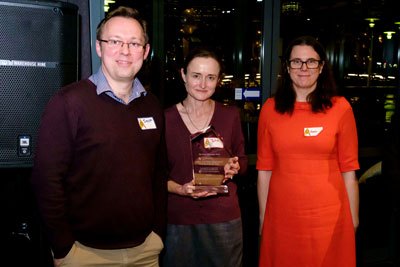
Peter McGregor Prize
Professor Peter McGregor was a highly dedicated scientist and a leader in astronomical instrumentation development. He received his PhD from Mt Stromlo Observatory in 1981, and after spending two years as a Carnegie Fellow in Pasadena, returned to Mt Stromlo to build an exceptional career at the ANU Research School of Astronomy and Astrophysics until his death in 2015 at the age of 59.
Peter designed and built instruments that brought significant scientific capability to the Australian astronomical community. He was the driving force behind two outstanding instruments for the Gemini 8m telescopes, the Near-Infrared Integral Field Spectrometer (NIFS) and the Gemini South Adaptive Optics Imager (GSAOI). He also led the design of a spectrograph (GMTIFS), that will be used in the next-generation Giant Magellan Telescope. Peter’s colleagues Matthew Colless and John Norris described him as ‘a quiet achiever; he was fair and modest and he had great common sense. When he spoke we listened.’

The Peter McGregor Prize is awarded by the Astronomical Society of Australia in recognition of exceptional achievement or innovation in astronomical instrumentation. The prize is normally awarded every three years.
The award is made to an individual or team for the design, invention or improvement of astronomical instrumentation and associated software techniques that have enabled significant advances in any areas of astronomy, without restriction to wavelength or space/ground-based observations.
The Prize consists of a commemorative plaque together with an award of $5,000. The Prize is presented at the Conference Dinner of the Annual Scientific Meeting of the Astronomical Society of Australia.
Nominations for the 2025 Peter McGregor Prize will open in December 2024 with a closing date in mid-February 2025.

Above: The inaugural prize winners, SAMI team members Scott Croom and Julia Bryant, receiving the 2016 award from the ASA President Virginia Kilborn.
Eligibility
To be eligible for the Prize:
- the nominee or leader of the team must be an Australian citizen or permanent resident at the nomination deadline,
- OR the nominated work must have been primarily carried out for or by an Australian institution.
Nominations
- a letter of nomination up to 2 pages in length, outlining in a clear and concise manner the achievement or innovation which forms the basis of the nomination.
- the nomination must demonstrate the significant scientific results made possible as a direct result of the instrumentation or associated software techniques.
- appropriate journal citations that support the nomination and demonstrate the impact of the instrumentation or software for astronomical research.
- a curriculum vitae for the nominee or leader of the nominated team, which includes a complete list of publications.
- the names and email addresses of two professional astronomers who would be willing to write supporting letters for the nomination outlining their view of the scientific impact of the achievement or innovation. At least one of these referees should be working outside of Australia and both referees should be international experts in the area of research covered by the nomination but cannot be members of the nominated team.
Nominations should be emailed to the ASA Prizes and Awards Coordinator Dr Tanya Hill – thill@museum.vic.gov.au.
An assessment committee nominated by the ASA Council will evaluate the submitted materials and make a recommendation to the ASA Council. The decision of the ASA Council is final, including the decision not to award a prize in any given year.
Limited travel funds to support attendance at the ASA Annual Scientific Meeting may be made available at the discretion of the ASA Council.
Previous Winners
- 2022 – The ASKAP radio telescope team
- The Australian Square Kilometre Array Pathfinder (ASKAP) is a radio telescope that uses novel technology to achieve extremely high survey speeds making it one of the best instruments in the world for mapping the sky at radio wavelengths. The ASKAP team developed the wide-field phased array feeds, consisting of 188 individual receivers arranged in a chequerboard pattern. Each of the 36 dishes of ASKAP is equipped with a phased array feed which enables ASKAP to take panoramic snapshots more than 100 times the size of the full Moon. The prize recognises the efforts of more than 100 engineers and researchers.
- 2019 – The DiFX collaboration
- The Distributed FX Correlator (DiFX) is a software package that contains tools necessary to turn an array of radio telescope signals into a functioning radio interferometer. The DiFX has contributed significantly to reducing the barrier to entry and play a major role in radio astronomy research internationally. The system has enabled a wide range of science, as testified by the very high number of references to the key technical papers. The open-access nature of the software has put a new tool in the hands of astronomers, with demonstrated positive results. Its scalability and adaptability has and continues to enable researchers to tailor its behaviour and pursue what would otherwise be difficult science goals.
- 2016 – The SAMI instrument team
- The development by the SAMI (Sydney-AAO Multi-object Integral-field) Instrument Team of the ‘hexabundle’ technology has been the primary enabler for the SAMI instrument, representing a significant leap in capability for multi-object spectroscopy. This instrument has made possible a qualitatively new view of galaxy structure and formation, and the long-term impact is likely to continue to grow through ongoing observations, as well as future developments of new instruments based on further developments of the technology.

